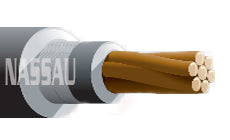
RSCC is a lightweight aerospace cable that serves up to 300 volts. Type B RSCC Aerodefense cable is made of silver coated copper or alloyed copper conductors. The cable is insulated with the cross linked ETFE and covered with a jacketing layer for protection. Silver plated copper shield is applied round the core holding the conductors together.
Features
1.Conductor
The cable is made of lightweight copper conductors making it easy to handle during installation. Lightweight RSCC Aerodefense cables require less effort to lift and move around, thus reducing termination time. Silver plating of the conductors reduces attenuation and impedance improving the electrical performance of the cable. Copper conductors with silver coating have good thermal conductivity with silver possessing 106% than copper. Plating facilitates solderability of the cable and provide resistivity to crimp contact.
2.Insulation
Insulation of the conductors protects the handler and the cable as well. The cross linked ETFE is non-conducting inhibiting the flow of electric currents keeping the handler safe from unnecessary electric shocks when installing the cable. XL-ETFE offers a great protection to the conductors from mechanical damages and harmful sunlight radiations. It prevents contacts between the conductors and the neutral wires eliminating power faults.
3.Jacketing & Shielding
Jacketing layer of this cable ensures that the cross linked ETFE insulation is not damaged by the punishing environmental conditions. This layer is also non-conducting thus preventing transfer of currents. XL-ETFE jacket is flexible making the cable to easily succumb to bending and folding. Shielding maintains the circular phase identification of the cable, preventing it from collapsing as a result of mechanical impacts and deformations. It ensures that the conductors are in their positions hence improving electrical flow.
Applications
This cable has a voltage rating of 300 volts, and can be deployed in wiring systems not exceeding 300V. It is installed in spacecraft at locations with temperatures of up to 200 degrees Celsius.
